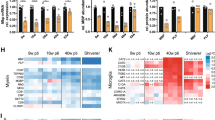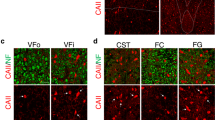Summary
The number of neuroglial cells in selected fiber tracts of 90-day-old quaking and normal mice was determined by a combination of light and electron microscopy. Oligodendrocytes of quaking mice are normal in number in the anterior commissure and corticospinal tract (in the cervical spinal cord) but are increased two- to fourfold in the optic nerve and the fasciculi cuneatus and gracilis (in the cervical spinal cord). The nuclei and perikarya are normal in size or smaller than normal.
Those tracts with the greatest hyperplasia of oligodendrocytes also have the greatest conten of myelin, suggesting that cell number influences content of myelin. However, the volume of myelin per oligodendrocyte also varies, between 2 and 11% of normal, in the different tracts of the mutant.
The hyperplasia of oligodendrocytes in quaking mice may arise as compensation for their decreased production of myelin and reflect a normal plasticity in the processes of myelination. If so, the mutant may be a useful system for study of the regulation of myelogenesis.
Similar content being viewed by others
References
Abercrombie, M.: Estimation of nuclear population from microtome sections. Anat. Rec. 94, 238–247 (1946)
Baumann, N., Bourré, J. M., Jacque, C., Harpin, M. L.: Lipid composition of quaking mouse myelin: comparison with normal mouse myelin in the adult and during development. J. Neurochem. 20, 753–759 (1973)
Baumann, N. A., Harpin, M. L., Bourré, J. M.: Long chain fatty acid formation: key step in myelination studied in mutant mice. Nature (Lond.) 227, 960–961 (1970)
Baumann, N. A., Jacque, C., Pollet, S., Harpin, M. L.: Étude biochimique de la mutation “quaking” chez la souris. Analyse des lipids et des acides gras du cerveau. C. R. Acad. Sci. (Paris) 264D, 2953–2956 (1967)
Baumann, N. A., Jacque, C. A., Pollet, S. A., Harpin, M. L.: Fatty acid and lipid composition of the brain of a myelin-deficient mutant, the “quaking” mouse. Europ. J. Biochem. 4, 340–344 (1968)
Berger, B.: Quelques aspects ultrastructuraux de la substance blanche chez la souris quaking. Brain Res. 25, 35–53 (1971)
Bobillier, P., Seguin, S., Renaud, B., Valatx, J. L.: Analyse electrophoretique comaree des proteines cerebrales totales, solubles et particulaires, chez cinq souches de souris. J. Neurochem. 20, 807–819 (1973)
Bourré, J. M., Pollet, S., Dadu, O., Baumann, N.: Biosynthèse des acides gras dans les microsomes de cerveau de souris normale et quaking. C. R. Acad. Sci. (Paris) 273D, 1534–1537 (1971)
Cotantino Ceccarini, E., Morell, P.: Quaking mouse: in vitro studies of brain sphingolipid biosynthesis. Brain Res. 29, 75–84 (1971)
Dawson, R.M.C., Clarke, N.: Cerebral phospholipids in quaking mice. J. Neurochem. 18, 1313–1316 (1971)
Friedrich, V. L., Jr.: The myelin deficit in quaking mice. Brain Res. 82, 168–172 (1974)
Friedrich, V. L., Jr., Hauser, G.: Biosynthesis of psychosine and levels of cerebrosides in the central and peripheral nervous systems of quaking mice. J. Neurochem. 20, 1131–1141 (1973)
Goldberg, I., Schechter, I., Bloch, K.: Fatty-acyl-coenzyme A elongation in brain of normal and quaking mice. Science 182, 497–498 (1973)
Greenfield, S., Norton, W. T., Morell, P.: Quaking mouse: isolation and characterization of myelin protein. J. Neurochem. 18, 2119–2128 (1971)
Greson, N. A., Oxberry, I. M.: The composition of myelin from the mutant mouse “quaking”. J. Neurochem. 19, 1065–1071 (1972)
Hauser, G., Eichberg, J., Jacobs, S.: Polyphosphoinositide levels and biosynthesis in quaking mouse brain. Biochem. biophys. Res. Commun. 43, 1072–1080 (1971)
Hogan, E.C., Joseph, K. C.: Composition of cerebral lipids in murine leucodystrophy: the quaking mutant. J. Neurochem. 17, 1209–1214 (1970)
Jacque, C., Bourré, J. M., Moreno, P., Baumann, N.: Ètude des lipides cérébraux de la so “quaking” au cours de la myelinisation. C. R. Acad. Sci. (Paris) 271, 798–801 (1970)
Jacque, C. M., Harpin, M. L., Baumann, N. A.: Brain lipid analysis of a myelin deficient mutant, the “quaking” mouse. Europ. J. Biochem. 11, 218–224 (1969)
Joseph, K. C., Druse, M. J., Newell, L. R., Hogan, E. L.: Fatty acid composition of cerebrosides, sulfatides and ceramides in murine leucodystrophy: the quaking mutant. J. Neurochem. 19: 307–312 (1972)
Kandutsch, A. A., Saucier, S. E.: Sterol and fattyacid synthesis in developing brains of three myelin deficient mouse mutants. Biochim. biophys. Acta (Amst.) 260, 26–234 (1972)
Kanfer, J. N., Sargent, A.: Sphingolipid biosynthesis by particulate fractions of normal and “quaking” mouse brain. Lipids 6, 682–684 (1971)
Kishimoto, Y.: Abnormality in sphingolipid fatty acids from sciatic nerve and brain of quaking mice. J. Neurochem. 18, 1365–1368 (1971)
Kruger, L., Maxwell, D. S.: Electron microscopy of oligodendrocytes in normal rat cerebrum. Amer. J. Anat. 118, 411–436 (1966)
Kruger, L., Maxwell, D. S.: Comparative fine structure of vertebrate neuroglia: teleosts and reptiles. J. comp. Neurol. 129, 115–142 (1967)
Kurihara, T., Nussbaum, T. L., Mandel, P.: 2′,3′-cyclic nucleotide 3′-phosphohydrolase in brains of mutant mice with deficient myelination. J. Neurochem. 17, 993–997 (1970)
Lerner, P., Campagnoni, A. T., Sampugna, J.: Proteolipids in the developing brains of normal mice and myelin deficient mutants. J. Neurochem. 22, 163–170 (1974)
Ling, E. A., Paterson, J. A., Privat, A., Mori, S., Leblond, C. P.: Investigations of glial cells in semithin sections. I. Identification of glial cells in the brain of young rats. J. comp. Neurol. 149, 43–72 (1973)
Matthews, M. A., Duncan, D.: A quantitative study of morphological changes accompanying the initiation and progress of myelin production in the dorsal funiculus of the rat spinal cord. J. comp. Neurol. 142, 1–22 (1971)
Neskovic, N., Nussbaum, J. L., Mandel, P.: A study of glycolipid metabolism in myelination disorder of jimpy and quaking mice. Brain Res. 21, 39–53 (1970)
Noskovic, N. M., Sarlieve, L. L., Mandel, P.: Biosynthesis of glycolipids in myelin deficient mutants: brain glycosyl transferases in jimpy and quaking mice. Brain Res. 42, 147–157 (1972)
Nussbaum, J. L., Mandel, P.: Brain proteolipids in neurological mutant mice. Brain Res. 61, 295–310 (1973)
Olafson, R. W., Drummond, G.I., Lee, J. F.: Studies on 2′3′ cyclic nucleotide 3′-phosphohydrolase from brain. Canad. J. Biochem. 48, 961–966 (1969)
Palay, S. L., Chan-Palay, V.: Cerebellar cortex, cytology and organization. Berlin-Heidelberg-New York: Springer 1974
Peters, A., Palay, S. L., Webster, H. deF.: The fine structure of the nervous system. The cells and their processes. New York: Harper and Row 1970
Reasor, M. J., Kanfer, J. N.: Alterations of the sphingolipid composition in the brains of the “quaking” mouse and the “jimpy” mouse. Life Sci. 8 (II), 1055–1060 (1960)
Richardson, K. C., Jarett, L., Finke, E. H.: Embedding in epoxy resins for ultrathin sectioning in electron microscopy. Stain Technol. 35, 313–323 (1960)
Samorajski, T., Friede, R. L., Reimer, P. R.: Hypomyelination in the quaking mouse. A model for the analysis of disturbed myelin formation. J. Neuropath. exp. Neurol. 29, 507–523 (1970)
Sarlieve, L., Neskovic, N., Rebel, G., Mandel, P.: Some properties of brain PAPS-cerebroside sulphotransferase in jimpy and quaking mice. Neurobiol. 2, 70–82 (1972)
Sidman, R. L., Dickie, M. M., Appel, S. H.: Mutant mice quaking and jimpy with deficient myelination in the central nervous system. Science 144, 309–311 (1964)
Sidman, R. L., Green, M. C., Appel, S. H., Catalog of the neurological mutants of the mouse. Cambridge, Mass.: Harvard University Press 1965
Siegel, S.: Nonparametric statistics for the behavioral sciences. New York: McGraw-Hill, Inc. 1956
Singh, H., Spritz, N., Geyer, B.: Studies of brain myelin in the “quaking mouse”. J. Lipid Res. 12, 473–481 (1971)
Skoff, R. P., Vaughn, J. E.: An autoradiographic study of cellular proliferation in degenerating rat optic nerve. J. comp. Neurol. 141, 133–155 (1971)
Vaughn, D. W., Peters, A.: Neuroglial cells in the cerebral cortex of rats from young adulthood to old age: an electron microscopic study. J. Neurocytol. 3, 405–429 (1974)
Vaughn, J. E.: An electron microscope analysis of gliogenesis in rat optic nerves. Z. Zellforsch. 94, 293–324 (1969)
Vaughn, J. E., Hinds, P. L., Skoff, R. P.: Electron microscopic studies of Wallerian degeneration in rat optic nerves. I. The multipotential glia. J. comp. Neurol. 140, 175–206 (1970)
Vaughn, J. E., Peters, A.: A third neuroglial cell type. An electron microscopic study. J. comp. Neurol. 133, 269–288 (1968)
Vaughn, J. E., Skoff, R. P.: Neuroglia in experimentally altered central nervous system. In: The structure and function of nervous tissue, vol. V (G. H. Bourne, ed.), p. 39–72. New York: Academic Press 1972
Watanabe, I., Bingle, G. J.: Demyelination in the brain of the quaking mouse: an electron microscopic study. J. Neuropath. exp. Neurol. 29, 150 (1970)
Watanabe, I., Bingle, G. J.: Dysmyelination in “quaking” mouse. Electron microscopic study. J. Neuropath. exp. Neurol. 31, 352–369 (1972)
Weibel, E. R.: Stereological principles for morphometry in electron microscopic cytology. Int. Rev. Cytol. 26, 235–302 (1969)
Wisniewski, H., Morell, P.: Quaking mouse: ultrastructural evidence for arrest of myelogenesis. Brain Res. 29, 63–73 (1971)
Author information
Authors and Affiliations
Additional information
Supported by Training Grant MH-07084 and Research Grants NS-03659 and NS-09904 from the U.S. Public Health Service and Training Grant NS-05591 from the National Institute of Neurological and Communicative Diseases and Stroke. This work was submitted to Harvard University in partial fulfillment of requirements for the degree of Doctor of Philosophy. I am indebted to Dr. S. L. Palay for his generous support and guidance.
Rights and permissions
About this article
Cite this article
Friedrich, V.L. Hyperplasia of oligodendrocytes in quaking mice. Anat. Embryol. 147, 259–271 (1975). https://doi.org/10.1007/BF00315075
Received:
Issue Date:
DOI: https://doi.org/10.1007/BF00315075




